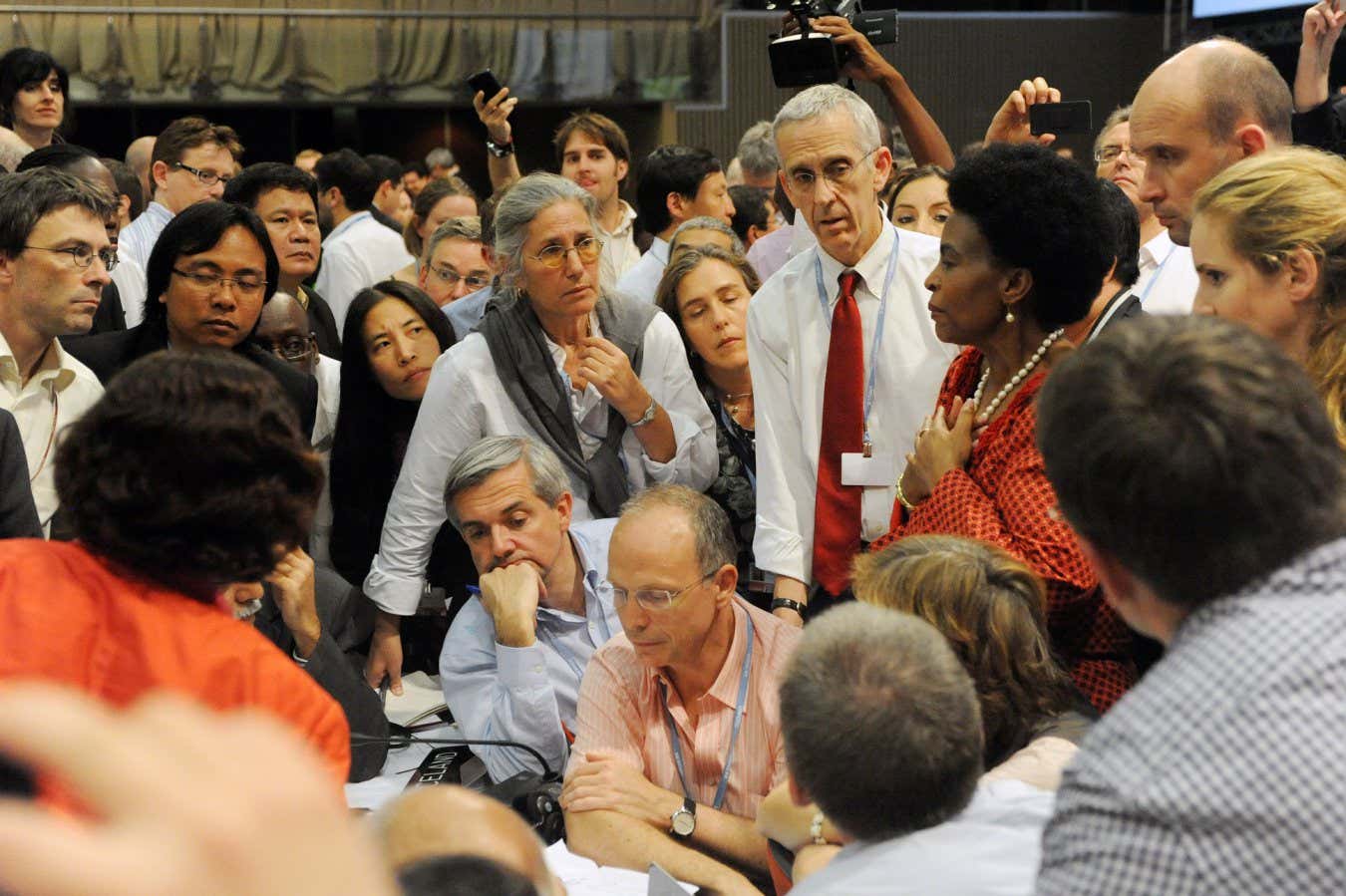

Peter Betts (seated, pink shirt) at COP17 in Durban, South Africa, in 2011
IISD/ENB Leila Mead
The Climate Diplomat
Peter Betts, Profile Editions
Climate negotiators, lobbyists and world leaders will descend on the Brazilian rainforest city of Belém next month for this year’s UN climate summit, COP30.
For anyone who has been to a COP summit, or tried to follow one from afar, the meetings can feel completely bewildering. Dozens of parallel negotiating tracks take place at the same time, replete with cryptic agendas and buzzword-y labels, ranging from “dialogues” and “consultations” to “informal informal” discussions.
To an observer, it can feel like a vast talking shop, wrapped up in its own conventions and with little relevance to the outside world. Thankfully, we have the wisdom of Peter Betts, a legendary figure in COP circles, to set us straight.
Outsiders are unlikely to have heard of Betts. But as the former lead climate negotiator for the UK and the EU, he played a central role in laying the groundwork for the Paris Agreement and in steering negotiations that got it over the line in 2015.
Betts sadly died of a brain tumour in October 2023, and his book, The Climate Diplomat: A personal history of the COP conferences, was published posthumously this August. It offers an insider’s account of what goes on at climate summits and takes us through their modern history, beginning when Betts took charge of UK international climate policy in 1998.
The first thing to become clear is that, although COPs are often held in far-flung locations, from Peru to Paris, Durban to Dubai, the life of a climate negotiator is hardly glamorous. National teams spend years strategising and planning their negotiating tactics for the annual two-week summits, only to spend the entire fortnight locked in windowless temporary buildings as they thrash out the fine details.
“
Amid the chaos, negotiators must find a way to bring everyone to the table and reach consensus
“
At COP17 in Durban, South Africa, Betts recalls how delegation offices were sited underground in a car park that “reeked of petrol and diesel fumes”, while at COP15 in Copenhagen, Denmark, the food “consisted almost exclusively of large circular rolls filled with a brown paste”. Clearly, climate diplomats aren’t in it for the jet-setting lifestyle; they truly believe this is the best way to solve the climate crisis.
Slowly, over the course of the book, it becomes clear why, as Betts takes us on a crash course on how a COP summit works, including the rules governing meetings and the negotiating positions and objectives of different countries.
The sheer range of issues is mind-boggling: some nations focus on securing more financial aid for development, others want nations to step up and commit to ambitious cuts to greenhouse gas emissions, while some are simply there to obstruct progress and maintain the status quo. Each country is also hamstrung by its own domestic politics, financial position and cultural outlook.
Amid the chaos, negotiators must find a way to bring everyone to the table and reach consensus – unanimous, no less – on the next steps to solve climate change. To call this a tall order is indeed a colossal understatement.
Betts writes with clarity and an often acerbic wit, even if there are some dense sections on, say, the intricacies of multilateral climate finance. But, gradually, you start to understand how the COP sausage is made, and how the strands align to build a finely balanced agenda in the hope of bringing nations together under a common goal.
Where things really come alive is when we are taken behind the scenes of the major summits – Copenhagen, Paris, Glasgow – and given the inside track on how things unfolded. We hear of prime ministers and presidents “robotically eating biscuits” in crunch meetings, stealing the show with unplanned, “damaging” press conferences, hiding in the VIP areas from their teams and “exploding” with anger when things don’t go their way.
There’s also more than enough gossip about Whitehall movers and shakers to keep British politicos engaged, and some perceptive insights into how climate campaigners have fallen short – and sometimes even damaged progress on emissions reduction – with their lobbying strategies.
There are plenty of people who dismiss the role of these summits in driving global climate action, arguing that they are little more than a tortuous gab fest. But the evidence shows otherwise: before the Paris Agreement was struck in 2015, the world was on course for 5°C of warming by the end of the century. A decade later, that trajectory has fallen to about 2.7°C – still far too high, but a long way from the truly catastrophic fate we were headed towards.
Diplomacy can change the world. In this book, Betts provides an unparalleled insight into exactly how this change can happen.
Topics:



